>
Tetraodontiformes (Puffers and filefishes) >
Diodontidae (Porcupinefishes (burrfishes))
Etymology: Chilomycterus: Greek, cheilos = lip + Greek, mykter, -eros = nose (Ref. 45335).
More on author: Linnaeus.
Environment: milieu / climate zone / depth range / distribution range
Ecologie
marien rifbewoner; diepte 20 - 100 m (Ref. 9680). Subtropical; - 24°S, 98°W - 34°W
Circumglobal: Gulf of Mexico, Atlantic, Indian and Pacific oceans.
Grootte / Gewicht / Leeftijd
Maturity: Lm ? range ? - ? cm
Max length : 69.7 cm NG mannelijk / geslacht onbekend; (Ref. 89467); common length : 30.0 cm TL mannelijk / geslacht onbekend; (Ref. 26999)
Dorsale stekels (totaal) : 0; Dorsale zachte stralen (totaal) : 12 - 14; Anale stekels: 0; Anale zachte stralen: 11 - 14. Adults grey to brown with a black gular band and small black spots on upper surfaces and fins; pelagic juveniles blue with dark spots above, the spots descending to belly (Ref. 4423).
Adults found in reefs and over soft bottoms to depths of 100 m, but may occur deeper in the tropics (Ref. 30573). Often found washed up on beaches. Known to brace themselves against the substrate to sleep at night (Ref. 4930). Appear to be active during the day. Juveniles often with floating weeds (Ref. 48637). Solitary. Juveniles pelagic in oceanic surface waters (Ref. 30573). Feed on hard-shelled invertebrates. Not usually marketed.
Levenscyclus en paargedrag
Maturities | Voortplanting | Spawnings | Egg(s) | Fecundities | Larven
Leis, J.M., 2001. Diodontidae. Porcupine fishes (burrfishes). p. 3958-3965. In K.E. Carpenter and V. Niem (eds.) FAO species identification guide for fishery purposes. The living marine resources of the Western Central Pacific. Vol. 6. Bony fishes part 4 (Labridae to Latimeriidae), estuarine crocodiles. FAO, Rome. (Ref. 9680)
Status op de Rode Lijst van het IUCN (Ref. 130435)
Gevaar voor de mens
Venomous
Gebruik door de mens
Visserij: van geen belang
Tools
Speciale rapporten
Download XML
Internetbronnen
Estimates based on models
Preferred temperature (Ref.
123201): 18.4 - 28.3, mean 27 °C (based on 959 cells).
Fylogenetische diversiteitsindex (Ref.
82804): PD
50 = 0.5313 [Uniqueness, from 0.5 = low to 2.0 = high].
Bayesian length-weight: a=0.04786 (0.01967 - 0.11644), b=2.82 (2.61 - 3.03), in cm total length, based on LWR estimates for this (Sub)family-body shape (Ref.
93245).
Trofisch niveau (Ref.
69278): 3.5 ±0.41 se; based on food items.
Weerstandsvermogen (Ref.
120179): Hoog, minimale populatieverdubbelingstijd minder dan 15 maanden (Preliminary K or Fecundity.).
Fishing Vulnerability (Ref.
59153): Low vulnerability (20 of 100).
Nutrients (Ref.
124155): Calcium = 18 [7, 59] mg/100g; Iron = 0.558 [0.274, 1.366] mg/100g; Protein = 19.2 [17.0, 21.4] %; Omega3 = 0.166 [0.086, 0.318] g/100g; Selenium = 25.4 [10.8, 56.7] μg/100g; VitaminA = 17.8 [4.5, 80.2] μg/100g; Zinc = 0.572 [0.367, 0.913] mg/100g (wet weight);
